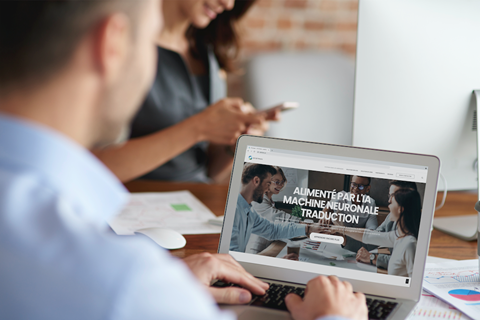Machine translation technology can translate millions of words in a single day. While translation is accurate and efficient, for some documents , it cannot fully replace a human translator. The machine may miss finer nuances like humor, emotion, or sarcasm. In addition, it may sometimes translate difficult words out of context or mistranslate a proper noun. For example, consider the sentence, “My dog, King, went to the market.” King is the dog’s name, and the French translation should be “Mon chien, King, est allé au marché.” However, the software may mistranslate it as “Mon chien, le roi est allé au marché.” which changes the meaning to dog and king went to market. That is why the human touch is essential.
Machine Translation Post-Edition (MTPE) is the process of getting a human translator to read, check, and edit the output of software translation. It improves document quality without significantly adding to translation expenses.
It is so important for the industry now that this subject has been addressed by the International Organization for Standardization (ISO), which has imposed the ISO 18587 standard. This standard specifies the requirements needed to carry out post-editing.
Types of Machine Translation Post Editing
Post-editing is usually of two types:
Light touch post-editing
The translator scans the document quickly and checks for apparent mistakes. They look out for missing or out-of-context information. They ensure the document’s overall message is clear before checking the following document. The translator double checks the translated document communicates the original meaning to the new audience. They make sure to use terms familiar to the audience. The goal is to check quickly and efficiently without compromising overall quality.
Full post-editing
The translator carefully edits every document until it is 100% perfect. For example, the translator may:
– Fix all grammatical errors and modify syntax.
– Re-organize passages or sentences to suit the target language better.
– Re-write some document portions for creativity, humor, or reader engagement.
– Update technical details like statistics or examples for the target audience. For example, if the original document gave some data about the USA, the translator will change it to provide data about the target location.
A quick comparison of the two types is given below :
| Light touch | Full editing | |
| Goal | Quick check to get the message across to the target audience. | Detailed check for full quality improvement. |
| Corrections | Only significant errors. | Every tiny detail. |
| Suitable for | Internal communication, short documents, and digital media. | Publishing in books, journals, print media, or critical business documentation. |
Light touch post-editing best practices
Here are some tips to improve the speed of light touch post-editing without compromising efficiency.
Scan first, edit later
Scan a paragraph and think of changes you want to make. If you can’t think of anything obviously wrong in the first three seconds, move on. Your goal should be to maximize the use of machine-translated output. Don’t delete existing content unnecessarily.
Double-check language nuances.
Find and fix sentences that sound odd or out of context. Look out for missing or inaccurate information or any big jump in ideas. You should double-check:
- Proper nouns
- Numbers or sentences with numerical information
- Terminology specific to the domain, like medical or financial terms.
- Dialog or conversations in the text that may contain informal language.
- Sentence tone and style, like business documents, have a formal tone in the target language.
Full post-editing best practices
High-quality full post-editing actually begins with pre-editing. The human translator checks and improves the source language text before machine input. Some things the human translator can fix in the source document include:
- Writing sentences in the active voice, so it is clear who the doer is.
- Re-writing long or overly complex sentences with too many conjunctions or adverbs.
- Changing words that have double meanings. (Like the word arm in he touched my arm vs. I arm myself with guns)
Pre-editing improves machine translation output and makes post-editing more efficient. Then during post-editing, the translator can improve the document further using their advanced literary and linguistic skills.
Machine translation post-editing checklist
The following checklist will help you improve the quality of all MTPE tasks.
- Read translation guidelines and requirements before you start.
- Basic grammar and punctuation check.
- Check for double meanings or replace them with synonyms where possible.
- Check for formal vs. informal language and words based on document context.
- Make sure correct noun and adjective combinations are present. (For example, in English, a beautiful boy is odd – the better term is a handsome boy.)
- Check against the source text for missing or incorrect information.
- Read the whole document one last time before finalizing.
1. Error Identification and Correction
The first step in MPTE is identifying errors in the machine translation. This can include grammatical errors, incorrect translations, and awkward phrasing. Once errors have been identified, they can be corrected by a human translator.
2. Consistency Checking
Consistency checking is another important technique used in MPTE. This involves checking that translations are consistent throughout the document or project. This can include consistency in terminology, formatting, and style.
3. Fluency Improvement
Fluency improvement is the process of ensuring that the translated text reads naturally and smoothly in the target language. This can involve making changes to sentence structure, word choice, and phrasing to ensure that the translation sounds natural and is easy to read.
4. Cultural Adaptation
Cultural adaptation involves making changes to the translation to ensure that it is appropriate for the target audience. This can include adapting cultural references, idiomatic expressions, and humor to ensure that they are understood by the target audience.
Challenges of Machine Post-Translation Editing
While MPTE can provide many benefits, there are also some challenges to consider.
One of the main challenges is finding qualified translators who are experienced in MPTE. Not all translators are skilled in editing machine translations, and it can be challenging to find translators who have the necessary skills and experience.
Another challenge is ensuring consistency in the editing process. With multiple translators working on a project, it can be difficult to ensure that the editing is consistent throughout the project. This can lead to inconsistencies in terminology, style, and formatting, which can impact the overall quality of the translation.
Finally, post-editing means evaluate performance regularly. The participation of human translators in the translation process should also allow to continually check the MT output to ensure quality.
Advanced machine learning and neural network technology have exponentially improved the pace and volume of translation. However, translation and linguistic professionals are critical to any business translation task. Depending on your use case, you can ask them to quickly review the machine output or significantly improve it for your target audience. Machine translation post-editing can be done keeping time, budget, and quality requirements.





